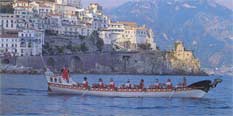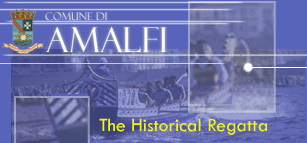The idea of an historical festival which could evoke the shining exploits from the epoch of the Ancient Italian Maritime Republics, was independently thought of by two enthusiasts, Mirro Chiaverini of Pisa and Francesco Amodio of Amalfi, at the end of the 1940's. The official charter for the race was instituted by the Regatta Board of the four Maritime Republics in Amalfi on December 10, 1955. From then on, every year, the festival, which consist of an historical parade and a rowing contest, takes place in turn in one of the four Ancient Maritime Republics.
The Regatta
The
regatta is a rowing contest using huge galleys constructed by Alvio Vaglini
according to twelfth century models. Each galley is propelled by eight rowers and guided by a helmsman. The four vessels, each
with fixed seats, a length of eight meters, and a weight of 760 kilograms,
blessed by the Venetian Patriarch, Angelo Roncalli and launched from the banks
of the Royal Gardens on June 9, 1956.
propelled by eight rowers and guided by a helmsman. The four vessels, each
with fixed seats, a length of eight meters, and a weight of 760 kilograms,
blessed by the Venetian Patriarch, Angelo Roncalli and launched from the banks
of the Royal Gardens on June 9, 1956.
The hulls of the ships are painted, according to the traditional colours of
the four maritime cities: Amalfi: blue; Pisa: red; Genoa: white; and Venice:
green. Each boat has its republic's flag hanging at its stern, and a figurehead
it its prow. For its figurehead, Amalfi uses a winged horse and a mermaid,
which is one of the principle motifs used by medieval galleys; Genoa, on the
other hand, uses a dragon evoking in protector, St. George; Pisa shows the
imperial, Germanic eagle, in memory of the loyal help which the Tuscan Republic
had offered the Swabians and the Ghibellines; Venice presents the lion of
St. Mark, which is the symbol of its holy protector.
The regatta is run over a straight 2000 meter long course. In Amalfi the race begins from Cape Vettica, from a promontory which contains a sixteenth century viceregal tower. The course then continues along the sinuous western coast to its end in Amalfi; here, the finish line is set in front of the Great Marina with the suggestive setting of Mount Aureo with the Ziro Tower, St. Lawrence of the Plain (a former monastery), the Cape Cross Quarter and the former convent and Tower of St. Francis in the background.
![]()

